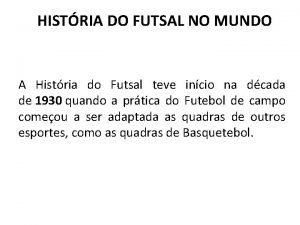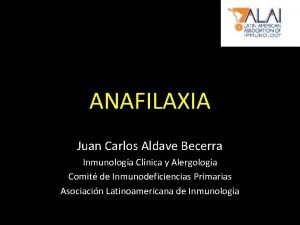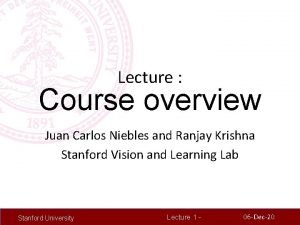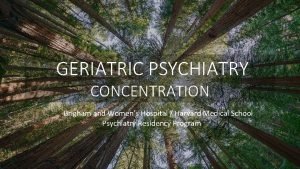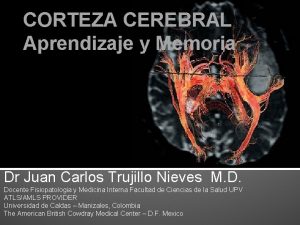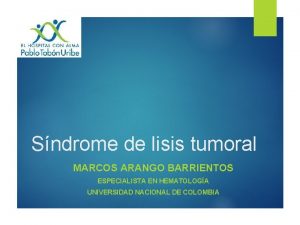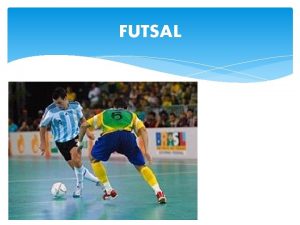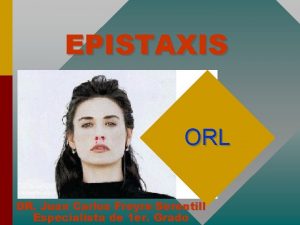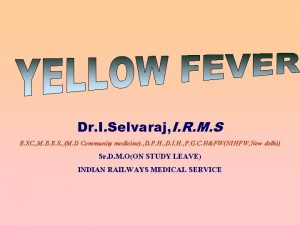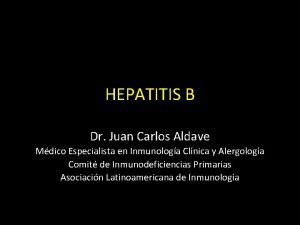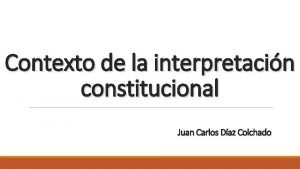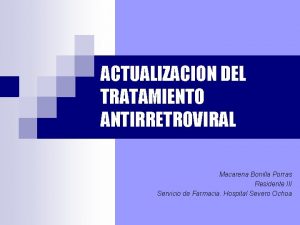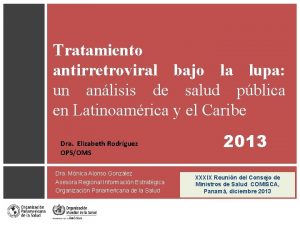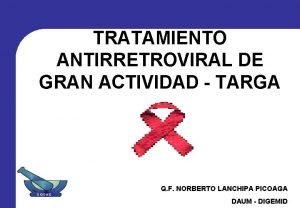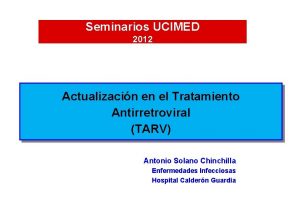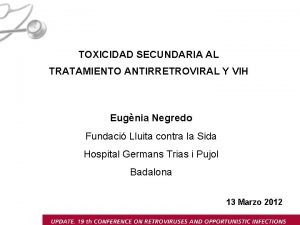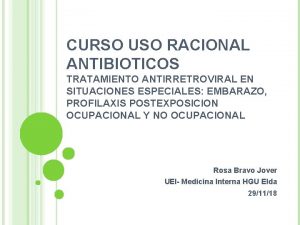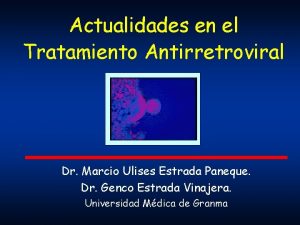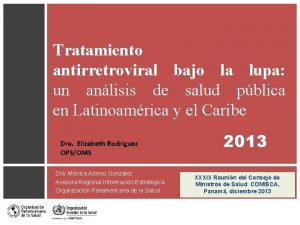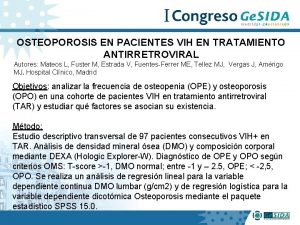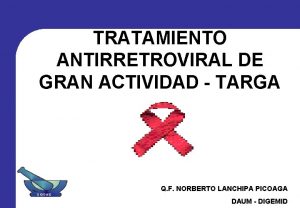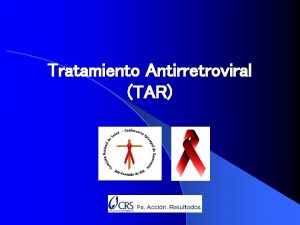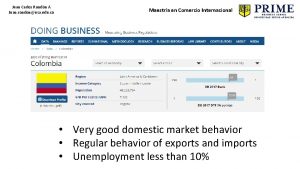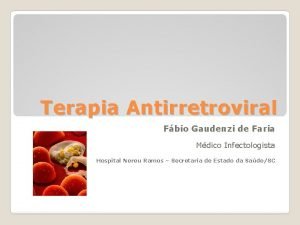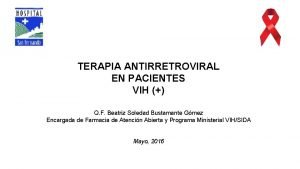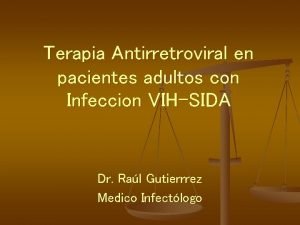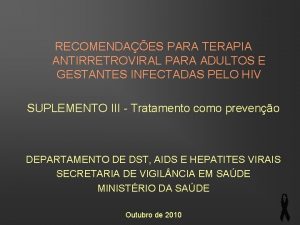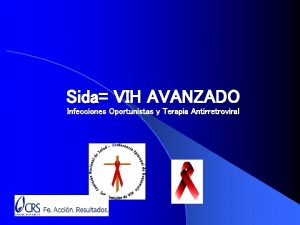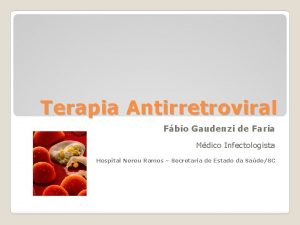PostCROI virtual 2020 Tratamiento antirretroviral II Juan Carlos

























- Slides: 25

Post-CROI (virtual) 2020 Tratamiento antirretroviral II Juan Carlos López Bernaldo de Quirós Hospital General Universitario Gregorio Marañón Madrid, 9 de junio de 2020

ATLAS-2 M Study Design Phase 3, randomized, multicenter, parallel-group, noninferiority, open-label study Maintenance Phaseǁ Screening Phase ATLAS Phase 3 study (CAB + RPV LA Q 4 W)* n=391‡ ATLAS SOC arm + additional SOC participants†: PI-, NNRTI-, or INSTIbased regimen with 2 NRTIs Q 8 W CAB (600 mg) + RPV (900 mg) LA (n=522) Option to continue randomized CAB + RPV LA Q 4 W or Q 8 W at Week 100 Except participants from ATLAS already on LA therapy Q 4 W CAB (400 mg) + RPV (600 mg) LA (n=523) Wk 100 Wk 96 Wk 48 Wk 4¶ Day 1 n=654‡ Randomized 1: 1§ Oral CAB + RPV Extension Phase 1 o Endpoint *Participants transitioning from ATLAS must have been on CAB + RPV LA Q 4 W or a current ART regimen through at least Week 52 of the ATLAS study and had plasma HIV-1 RNA <50 c/m. L at screening. †SOC participants not transitioning from the ATLAS study were to be on uninterrupted current regimen (either the initial or second combined ART regimen) for at least 6 months prior to screening. Documented evidence of at least two plasma HIV-1 RNA measurements <50 c/m. L in the 12 months prior to screening, one within the 6 - to 12 -month window and one within 6 months prior to screening, was required. Participants were excluded if they had a history of virologic failure; evidence of viral resistance based on the presence of any resistance-associated major INSTI or NNRTI mutation (except K 103 N) from prior genotype assay results. ‡Intent-to-treat exposed population. § 1149 participants were screened, and 1049 participants were randomized. 4 participants did not receive study drug and therefore were not part of the ITT-E population. ǁParticipants who withdraw from the IM regimen must go into 52 -week long-term follow-up if randomized regimen is not yet locally approved and commercially available. ¶Participants on oral lead-in treatment attended a Week 4 visit to assess tolerability. In participants in the Q 4 W arm who had an oral lead-in, the first LA dose was CAB 600 mg + RPV 900 mg. Overton et al. CROI 2020; Boston, MA. Presentation 3334. 2

ATLAS-2 M virologic Snapshot Outcomes at Week 48 for ITT-E Proportion of Participants (%) 100 94, 3 Adjusted Treatment Difference at Week 48 (95% CI)* 93, 5 Q 8 W CAB + RPV LA 80 Q 4 W CAB + RPV LA Primary endpoint (≥ 50 c/m. L): 0. 8 – 0. 6 60 2. 2 4% NI margin -10 -8 -6 -4 -2 0 2 4 Difference (%) 40 1. 7 4. 0 1 Virologic Non-Response (≥ 50 c/m. L) Virologic Success (<50 c/m. L) 5, 5 No Virologic Data Participant numbers: n=522 Q 8; n=523 Q 4; CAB, cabotegravir; CI, confidence interval; CMH, Cochran–Mantel–Haenszel; LA, long-acting; NI, noninferiority; RPV, rilpivirine; Q 4 W, every 4 weeks; Q 8 W, every 8 weeks. – 2. 1 6 Q 8 W is noninferior to Q 4 W (Week 48) 8 10 Q 8 W Q 4 W 20 0 Q 4 W Q 8 W 0. 8 Key secondary endpoint (<50 c/m. L): Q 8 W is noninferior to Q 4 W (Week 48) 3. 7 – 10% NI margin -10 -8 -6 -4 -2 0 2 4 Difference (%) 6 8 10 *Based on CMH stratified analysis adjusting for the following baseline stratification factor: prior exposure to CAB + RPV (0 weeks, 1– 24 weeks, >24 weeks). Overton et al. CROI 2020; Boston, MA. Presentation 3334. 3

ATLAS-2 M virologic Snapshot Outcomes at Week 48 for ITT-E Snapshot outcome, ITT-E, n (%) Q 8 W (n=522) Q 4 W (n=523) HIV-1 RNA <50 c/m. L at Week 48 492 (94. 3) 489 (93. 5) HIV-1 RNA ≥ 50 c/m. L at Week 48 9 (1. 7) 5 (1. 0) Data in window not <50 c/m. L 3 (0. 6) 2 (0. 4) Discontinued for lack of efficacy 6 (1. 1) 2 (0. 4) 0 1 (0. 2) 21 (4. 0) 29 (5. 5) Discontinued for AE or death 9 (1. 7)* 13 (2. 5)† Discontinued for other reasons 12 (2. 3)‡ 16 (3. 1)§ Discontinued for other reasons while not <50 c/m. L No virologic data *Discontinuations for AEs (event level) include Q 8 W: Injection site pain (n=2), injection site abscess, injection site discomfort, skin lesion, fatigue, acute hepatitis B, asthenia, presyncope, pancreatitis acute, headache, rash maculo-papular (all n=1). †Q 4 W: injection site pain (n=11), abnormal dreams (n=2), injection site swelling (n=2), hyperhidrosis (n=2), fatigue (n=2), injection site nodule, influenza, headache, acute hepatitis B, dizziness, glioblastoma, allergic reaction, transaminase increase, depression, chills, insomnia, myalgia, nausea, presyncope, pyrexia, sleep disorder, disturbance in attention (all n=1). ‡Q 8 W: Withdrawal by participant (n=4), investigator decision (n=4), lost to follow-up (n=2), protocol deviation (n=1), lack of efficacy (n=1). §Q 4 W: Withdrawal by participant (n=12), protocol-specified withdrawal criteria met (pregnancy) (n=3), protocol deviation (n=1). AE, adverse event; ITT-E, intent-to-treat exposed; Q 4 W, every 4 weeks; Q 8 W, every 8 weeks. Overton et al. CROI 2020; Boston, MA. Presentation 3334. 4

ATLAS-2 M: Summary of Confirmed Virologic Failures n CVFs n (%) CVFs with RPV RAMs* RPV RAMs Observed at Failure CVFs with IN RAMs* IN RAMs Observed at Failure Q 8 W 522 8 (1. 5) 6/8 K 101 E, E 138 E/K, E 138 A, Y 188 L 5/8 Q 148 R, † N 155 H† Q 4 W 523 2 (0. 4) 1/2 K 101 E, M 230 L 2/2 E 138 E/K, Q 148 R, N 155 N/H • Post hoc baseline PBMC HIV-1 DNA results for Q 8 W arm: • • • 5/8 CVFs had pre-existing major RPV RAMs (E 138 A, Y 188 L, Y 181 Y/C, H 221 H/Y, E 138 E/A, Y 188 Y/F/H/L) 1/8 CVFs had a pre-existing major IN RAM (G 140 G/R) 5/8 CVFs had L 74 I polymorphism (3 subtype A or A 1, 1 subtype C, 1 complex subtype) • 9/10 CVFs re-suppressed on fully active oral HAART (1/10 non-compliance on PI-based ART) • All CVFs retained phenotypic sensitivity to dolutegravir • Factors contributing to CVF (e. g. baseline resistance and drug concentrations) are being further evaluated • PBMC HIV-1 DNA analysis underway across Phase 3 program *For those with observed RAMs at failure: 6/6 Q 8 W and 1/1 Q 4 W CVFs had RPV resistance (fold-change > 2), and 3/5 Q 8 W and 1/2 Q 4 W CVFs had CAB resistance (fold-change >2. 5); CVF definition: 2 consecutive plasma HIV-1 RNA levels ≥ 200 c/m. L after prior suppression to <200 c/m. L. †Or mixture ART, antiretroviral therapy; CVF, confirmed virologic failure; HAART, highly active antiretroviral therapy; IN, integrase; PBMC, peripheral blood mononuclear cell; PI, protease inhibitor; Q 4 W, every 4 weeks; Q 8 W, every 8 weeks ; RAM, resistance-associated mutation; RPV, rilpivirine. 5

ATLAS-2 M Injection Site Reactions Outcome, n (%), ITT-E Overall ISRs Participants with ISR (%) 100 Q 8 W 90 Number of injections Number of ISR events (events/injections)* Grade ≥ 3 – severe† Injection site reactions‡ Pain Nodule Discomfort Withdrawals due to injection-related reasons, participant n (%)§ Q 4 W 80 70 1° endpoint 60 50 40 30 20 10 0 Participants Q 8 W at visit Q 4 W 194 196 322 515 514 515 NA 513 511 508 NA 502 503 NA 502 496 499 NA 492 495 491 NA 490 493 488 NA 476 1 4 8 12 16 20 24 28 32 36 40 44 48 52 ay D k ee W k W k ee W k ee W k ee W Note: Day 1 only included participants with prior CAB + RPV exposure due to the oral lead-in phase. • 24, 181 injections were administered in total Q 8 W (n=522) 8470 2507 (30) Q 4 W (n=523) 15, 711 3152 (20) 43 (<1) 48 (<1) 2014 (24) 113 (1) 92 (1) 2567 (16) 204 (1) 110 (1) 6 (1) 11 (2) *All event-level ISR percentages are calculated from the total number of injections. Note: A single injection could result in more than one ISR. †There were no Grade 4 or Grade 5 ISRs. ‡ISRs occurring in >1% of injections in either the Q 4 W or Q 8 W arms are shown. §Q 8 W: 5 participants had an ISR leading to withdrawal and 1 participant withdrew consent from the study due to injection intolerability; Q 4 W: 5 participants had an ISR leading to withdrawal and 6 participants withdrew consent from the study due to injection intolerability. • <2% of participants discontinued due to injection-related reasons • The majority (98%, 5568/5659) of ISRs were Grade 1– 2, with a median duration of 3 days in both arms AE, adverse event; ISR, injection site reaction; ITT-E, intent-to-treat exposed; Q 4 W, every 4 weeks; Q 8 W, every 8 weeks. Overton et al. CROI 2020; Boston, MA. Presentation 3334. 6

FLAIR Study Design Phase 3, randomized, multicenter, parallel-group, noninferiority, open-label study Induction Phase Screening Phase N=809 ART naïve HIV-1 RNA ≥ 1000 c/m. L Any CD 4 count HBs. Ag-negative NNRTI RAMs excluded* n=629 DTG/ABC/3 TC single-tablet regimen for 20 weeks† Study Week − 20 − 4 Confirm HIV-1 RNA <50 c/m. L Extension Phase Maintenance Phase Switch to LA n=232 DTG/ABC/3 TC Oral daily n=283 Oral CAB + RPV n=283 Day 1 CAB (400 mg) + RPV LA (600 IM monthly n=278 4§ Randomization (1: 1) 48 Primary Endpoint Extensionǁ Switch to/continue CAB (400 mg) + RPV (600 mg) LA IM monthly n=475¶ mg)‡ 96 100 Data Cut-off 124 Oral Lead-In Analysis *NNRTI RAMs but not K 103 N were exclusionary or any known resistance to INIs. †If the participant had toxicity or intolerability in association with DTG/ABC/3 TC, one switch to an approved alternative background NRTI was permitted. Participants who were positive for HLA-B*5701 received DTG plus two alternative non-ABC NRTIs instead of DTG/ABC/3 TC (n=30). ‡Participants who withdraw/complete CAB + RPV LA enter 52 -week long-term follow-up. §Participants received initial loading doses of CAB 600 mg and RPV LA 900 mg at Week 4. Beginning at Week 8, participants received CAB 400 mg + RPV 600 mg LA injections every 4 weeks. ǁThe extension phase will continue indefinitely until CAB + RPV LA is either locally approved and commercially available, the participant no longer derives clinical benefit, the participant meets a protocol-defined reason for discontinuation, or until development of either CAB or RPV LA is terminated. ¶Estimate based on Maintenance Phase Conclusion Form – data on file. Orkin et al. CROI 2020; Boston, MA. Poster 482 LB. 7

FLAIR Week 96 Virologic Response Virologic Outcomes Proportion of Participants (%) 100 86, 6 Adjusted Treatment Difference (95% CI)* 89, 4 CAB + RPV LA 80 CAB + RPV LA (n=283) 60 DTG/ABC/3 TC (n=283) DTG/ABC/3 TC LA is noninferior to DTG/ABC/3 TC (≥ 50 c/m. L) at Week 96 0 – 2. 9 6% NI margin 40 20 10, 2 3, 2 0 3, 2 Virologic nonresponse (≥ 50 c/m. L) Virologic success (<50 c/m. L) 7, 4 -10 -8 No virologic data -6 -4 -2 0 2 Difference (%) 4 6 8 10 CAB + RPV LA DTG/ABC/3 TC LA is noninferior to DTG/ABC/3 TC (<50 c/m. L) at Week 96 – 2. 8 2. 5 – 8. 2 – 10% NI margin *Adjusted for sex and baseline HIV-1 RNA (< vs. ≥ 100, 000 c/m. L). -10 -8 -6 -4 -2 0 2 Difference (%) 4 6 8 10 Orkin et al. CROI 2020; Boston, MA. Poster 482 LB. 8

Snapshot Outcomes at FLAIR Week 96 (ITT-E) CAB + RPV LA n=283, n (%) DTG/ABC/3 TC n=283, n (%) HIV-1 RNA <50 c/m. L* 245 (86. 6) 253 (89. 4) HIV-1 RNA ≥ 50 c/m. L* 9 (3. 2) Data in window not below threshold 3 (1. 1) 2 (0. 7) Discontinued for lack of efficacy 6 (2. 1) 5 (1. 8) 0 2 (0. 7)† 29 (10. 2) 21 (7. 4) Discontinued due to AE‡ 12 (4. 2) 4 (1. 4) Discontinued for other reasons 16 (5. 7)§ 17 (6. 0)ǁ 1 (0. 4) 0 Discontinued for other reason while not below threshold No virologic data in Week 96 window On study but missing data in window *Per FDA Snapshot algorithm. † 1 relocation, 1 lost to follow-up. ‡No deaths occurred during the maintenance phase. §In the LA arm, 16 participants discontinued due to reasons other than AEs: 3 relocations, 2 intent to become pregnant, 2 tolerability of injections, 2 lost to follow-up, 1 need to initiate prohibited medication, 1 incarceration, 1 pregnancy, 1 frequency of visits, 1 burden of travel, 1 change of job, 1 unreliable with visits. ǁIn the DTG/ABC/3 TC arm, 17 participants discontinued due to reasons other than AEs: 4 frequency of visits, 3 non-compliance with study treatment and protocol procedures, 1 relocation, 1 participant decision to stop treatment, 1 late to attend visits, 1 lost to follow-up, 1 pregnancy, 1 burden of travel, 1 unspecified reason, 1 prohibited medication use, 1 substance abuse, 1 met protocol stopping criteria. • ‡LA • ‡DTG/ABC/3 TC arm: injection site pain (2), acute hepatitis B (2), discomfort/injection site pain/diarrhea/vomiting, hepatitis A/secondary syphilis, hepatitis A, hepatitis C, acute hepatitis C, transaminases increased, depression, and adenocarcinoma of the colon arm: suicide attempt, disturbance in attention/dysarthria/amnesia, dizziness/fatigue/nausea, renal failure Orkin et al. CROI 2020; Boston, MA. Poster 482 LB. 9

No New CVFs at FLAIR Week 96 in the LA Arm Variable CVF* between Week 48 and Week 96 Total CVF* through Week 96. Total treatment-emergent resistance CAB + RPV LA n=283, n (%) DTG/ABC/3 TC n=283, n (%) 0 1 (<1)† 4 (1. 4)‡ 4 (1. 4) 3 (1. 1)§ 0 *CVF is defined as rebound as indicated by 2 consecutive plasma HIV-1 RNA levels ≥ 200 c/m. L after prior suppression to <200 c/m. L. †DTG/ABC/3 TC CVF occurred at Week 64 with no resistance mutations. ‡One participant in FLAIR had oral CAB/RPV dosing interrupted due to a false-positive pregnancy test and upon re-initiation of oral therapy, had suspected virologic failure that was confirmed. §Subtype A 1 assignment based on Monogram Algorithm which does not include reference sequences for A 6, a predominant subtype in Russia. Further in-house analysis suggests that the subtype for all 3 is A 6. There were no virologic failures in the LA arm from Week 48 to Week 96 Orkin et al. CROI 2020; Boston, MA. Poster 482 LB. 10

Plasma RPV (ng/m. L) Plasma CAB (µg/m. L) FLAIR Plasma CAB and RPV Trough Concentrations 10 100 1 RPV (n=278) PA-IC 90 (12 ng/m. L) CAB (n=278) PA-IC 90 (0. 166 µg/m. L) 10 0, 1 4 8 12 16 20 24 28 32 36 40 44 48 52 56 60 80 88 96 Visit (Week) • Throughout the maintenance phase, plasma concentrations after IM CAB + RPV LA were comparable with those during efficacious oral regimens • Achievement of steady state for CAB was confirmed at Week 44 and was not reassessed using data through Week 96 • RPV had not achieved steady state by Week 44 and was not reassessed using data through Week 96. However, RPV pre-dose concentrations appeared to plateau between Week 60 and Week 96 Orkin et al. CROI 2020; Boston, MA. Poster 482 LB. 11

FLAIR Injection Site Reactions Overall ISRs* Participants with ISRs (%) 100 80 60 40 20 0 4 8 12 16 20 24 28 32 36 40 44 48 52 56 60 64 68 72 76 80 84 88 92 96 Study Week CAB + RPV LA n=283 12, 552 3100 (24. 7) 2730 (21. 7) 352 (2. 8) 18 (<1) Outcome, n (%) Number of injections ISR events, n (% of total injections) Grade 1 – mild Grade 2 – moderate Grade 3 – severe ISR events (most frequent), n (% of total injections) Pain Nodule Induration Warmth Pruritus Swelling Median duration of ISRs, days 2613 (20. 8) 132 (1. 1) 119 (<1) 56 (<1) 45 (<1) 3 Participant withdrawals due to ISR-related reasons, n (%) • ISRs leading to withdrawal • Withdrew consent due to intolerability of injections 6 (2. 1) 3 (1. 1) • The majority (3082/3100, 99%) of ISRs were Grade 1– 2 and most (89%) resolved within ≤ 7 days (median • duration, 3 days) Between Week 48 and 96, 2 participants withdrew due to ISR-related reasons, 1 for an ISR and 1 for intolerability of injections Orkin et al. CROI 2020; Boston, MA. Poster 482 LB. 12

Treatment discontinuation CAB + RPV LA LATTE-2 (P 2 b) (n=14) ATLAS (P 3) (n=24) Overall (n=38) Q 4 W 9 24 33 Q 8 W 5 NA 5 Female 1 8 9 Male 13 16 29 34. 5 (21 - 48) 38 (21 - 51) 37. 5 (21 - 51) Baseline Weight (kg) (median, range) 72. 3 (52. 7 - 95. 0) 71. 6 (41. 2 - 120) 72. 3 (41. 2 - 120) Baseline BMI (kg/m 2) (median, range) 24. 2 (19. 4 - 29. 3) 23. 3 (15. 3 - 37. 9) 23. 7 (15. 3 - 37. 9) Parameter Study Regimen Sex Age (years) (median, range) Ford et al. CROI 2020; Boston, MA. Poster 466. 13

Individual Concentration-Time Profiles Following Discontinuation of Long. Acting Treatment in LATTE-2 and ATLAS (CAB left, RPV right) • LLOQ, lower limit of quantification; PA-IC 90, protein adjusted IC 90. Ford et al. CROI 2020; Boston, MA. Poster 466.

Median (5 th, 95 th Percentile) Parameter Estimates of Individual LTFU Concentration-Time Data Parameter CAB (n=34) RPV (n=27) Slope (hr-1) 0. 00064 (0. 00028, 0. 00183) 0. 00014 (0. 00008, 0. 0003) 6. 4 (2. 3, 14. 7)a 29. 6 (15. 2, 56. 7)a Half-life (weeks)a • a. Apparent terminal phase half-life should be interpreted with caution as data were insufficient (<2 half-life lengths) for accurate estimation in some profiles. Ford et al. CROI 2020; Boston, MA. Poster 466. 15

Range of CAB (left) and RPV (right) Concentrations by LTFU Visit Following Discontinuation of Q 4 W and Q 8 W Regimens Ford et al. CROI 2020; Boston, MA. Poster 466.

Novel Capsid Inhibitor (GS-6207): Experience to Date Multistage Mechanism of Action of GS-6207 EC 50 half-maximal effective concentration determined in peripheral blood mononuclear cells using wild-type (WT) HIV-1 patient isolates with various HIV-1 subtypes. IN, integrase; Pol, polymerase; RT, reverse transcriptase. Daar E et al. Abstract 469. Begley R et al. Abstract 470. Margot NA. Abstract 529.

Novel Capsid Inhibitor (GS-6207): Experience to Date Dose-dependent Antiviral Activity of Subcutaneous, Long-acting GS-6207 (Phase 1 b) Start of B/F/TAF Single SC GS-6207 Dose Mean Change in HIV-1 RNA, Log 10 Copies/m. L (95% CI) 0 -0. 5 -1. 0 -1. 3* -1. 5 -1. 8 -2. 0 Placebo (n=10) GS-6207 20 mg (n=6) GS-6207 50 mg (n=6) GS-6207 150 mg (n=6) GS-6207 450 mg (n=6) GS-6207 750 mg (n=5) -2. 5 -3. 0 -2. 1† -2. 3 Site-directed mutagenesis GAG mutations had no effect on potency of GS-6207 -3. 5 1 2 3 4 6 5 Time (Day) 7 8 9 10 * Change (mean) on Day 10 in 20 -mg cohort was -1. 3 log 10 copies/m. L, while maximal change (mean) through Day 10 was -1. 4 log 10 copies/m. L; † Change (mean) on Day 10 in 450 -mg cohort was -2. 1 log 10 copies/m. L, while maximal change (mean) through Day 10 was -2. 2 log 10 copies/m. L GS-6207 oral tablets can be administered without regard to food 3 Daar E et al. Abstract 469. Begley R et al. Abstract 470. Margot NA. Abstract 529.

WEEKLY ORAL ISLATRAVIR EFFECTIVE AS PEP Markovitz M et al. Abstract 89

WEEKLY ORAL ISLATRAVIR EFFECTIVE AS PEP Markovitz M et al. Abstract 89

AAV 8 Vector to Deliver VRC 07 • Adenovirus-associated viral (AAV) vectors have an established safety record in humans • AAV 8 vector encoding HIV b. NAb VRC 07 has been developed • 7 HIV-infected participants on effective ARV therapy • 5 x 1010 vg/kg (n = 3) • 5 x 1011 vg/kg (n = 2) • 2, 5 x 1012 vg/kg (n = 2) • IM injection • Follow-up 7 -12 months • Adverse effects: local reactogenicity Casazza JP, et al. CROI 2020. Abstract 41 LB.

AAV 8 Vector to Deliver VRC 07 Concentrations Post Administration by AAV Vector VRC 07 Concentration (µg/ml) 1. 5 5 x 1010 vg/kg 5 x 1011 vg/kg 2. 5 x 1012 vg/kg 1. 0 0. 5 0 0 20 40 60 80 Week Post-product Administration AAV 8 -mediated gene transfer may offer a safe means to generate effective vectored immunoprophylaxis in humans. Casazza JP, et al. CROI 2020. Abstract 41 LB.

Infiltration of VRC 01 Into the Cerebrospinal Fluid in Humans: The RV 397 Study • RV 397 was a randomized, double-blind, placebo-controlled trial of participants who initiated suppressive ART during acute HIV infection • At month 24 ATI + b. NAb VRC 01 IV every 3 weeks • VRC 01 levels in CSF and blood before and after infusion • Three males, aged 18 -47 years, Fiebig stages 1 or 2 • All CSF HIV RNA was <80 copies/ml, CSF WBC <2 cells/l, CSF protein <38 mg/d. L, Prabhakaran M, et al. CROI 2020. Abstract #453.

Infiltration of VRC 01 Into the Cerebrospinal Fluid in Humans: The RV 397 Study VRC 01 levels measured in the CSF and plasma of 3 participants Plasma draw CSF draw ATI Last VRC 01 infusion First detectable viral load Plasma CSF Donor 3799 Donor 5040 Donor 3500 VRC 01, µg/ml 1000 10 1 1 0 10 20 30 40 50 60 70 80 Day • • • VCR 01 levels detected in CSF were 1000 -fold lower to plasma levels This difference is similar to 1000 -fold difference in Ig. G between CSF and plasma On average, 6% of all Ig. G in CSF was VCR 01, while it was 2% in plasma Prabhakaran M, et al. CROI 2020. Abstract #453.

Conclusiones • CAB + RPV LA puede administrarse cada 8 semanas • Seguro y pocos efectos adversos • Cola farmacocinética larga (mas con RPV) • Asegurar TAR supresivo durante mas de 1 año • Vienen fármacos potentes y con largas farmacocinéticas • Los b. NAbs continúan su andadura y prometen tener un sitio en el TAR
 Juan carlos passano
Juan carlos passano Biografia de juan carlos onetti
Biografia de juan carlos onetti Juan carlos gualdron
Juan carlos gualdron Juan carlos ceriani futsal
Juan carlos ceriani futsal Irene santolaya torrego
Irene santolaya torrego Juan carlos zambrano arciniegas
Juan carlos zambrano arciniegas Cs 131 stanford
Cs 131 stanford Juan carlos urizar
Juan carlos urizar Que es el valor de la responsabilidad
Que es el valor de la responsabilidad Juan carlos trujillo nieves
Juan carlos trujillo nieves Lisis terminologia medica
Lisis terminologia medica Futsal brief history
Futsal brief history Mancha vascular de kiesselbach
Mancha vascular de kiesselbach Juan carlos marmolejo
Juan carlos marmolejo Juan carlos olivares rojas
Juan carlos olivares rojas Juan carlos garcia salas
Juan carlos garcia salas Ies jc1
Ies jc1 Carlos juan finlay accomplishments
Carlos juan finlay accomplishments Juan carlos niebles
Juan carlos niebles Juan carlos onetti premios
Juan carlos onetti premios Juan carlos aldave
Juan carlos aldave El cerdito juan carlos onetti
El cerdito juan carlos onetti Juan carlos diaz colchado
Juan carlos diaz colchado Alma conductora
Alma conductora Juan carlos rossetti
Juan carlos rossetti Juan juan studio melina
Juan juan studio melina



